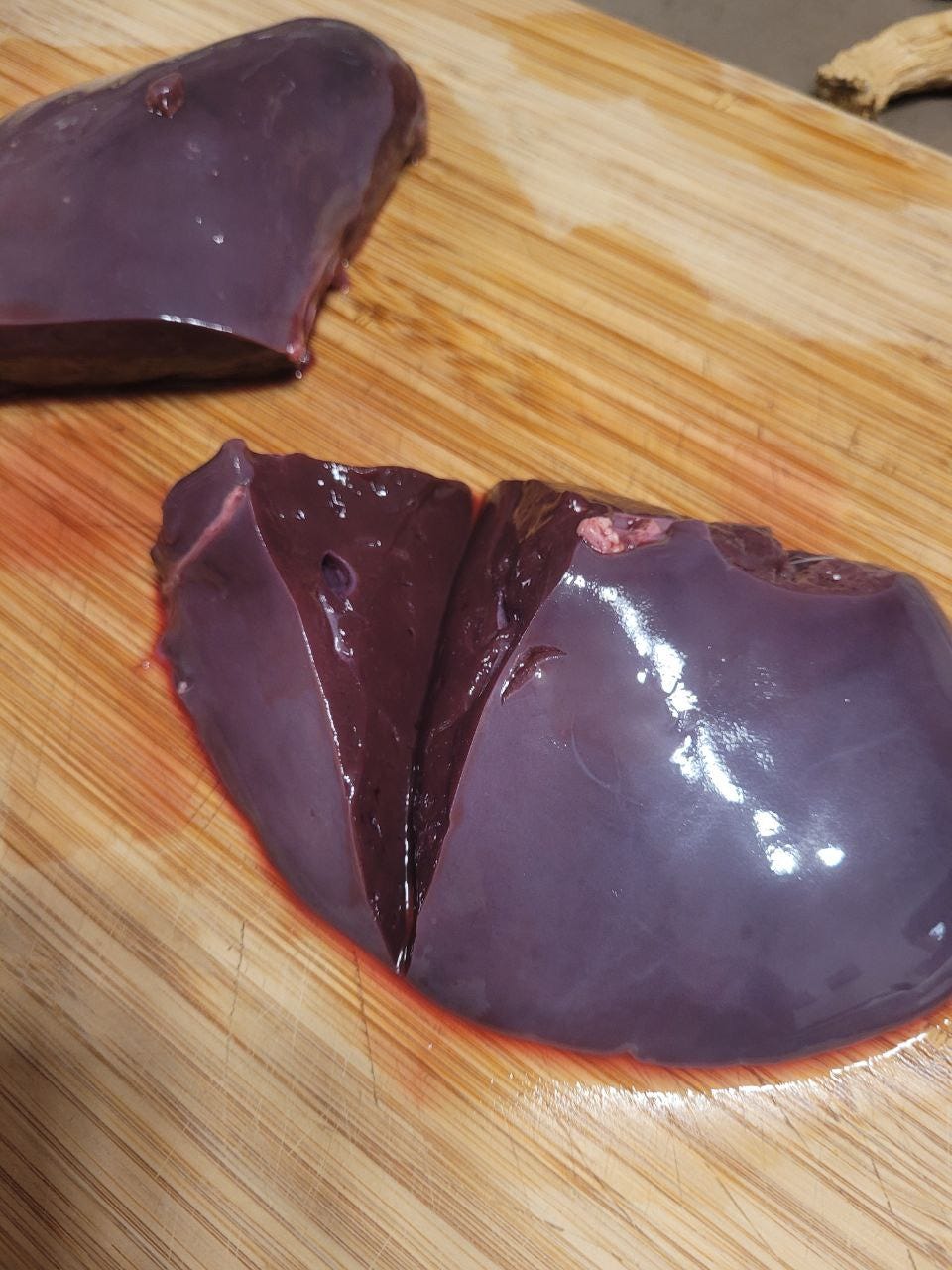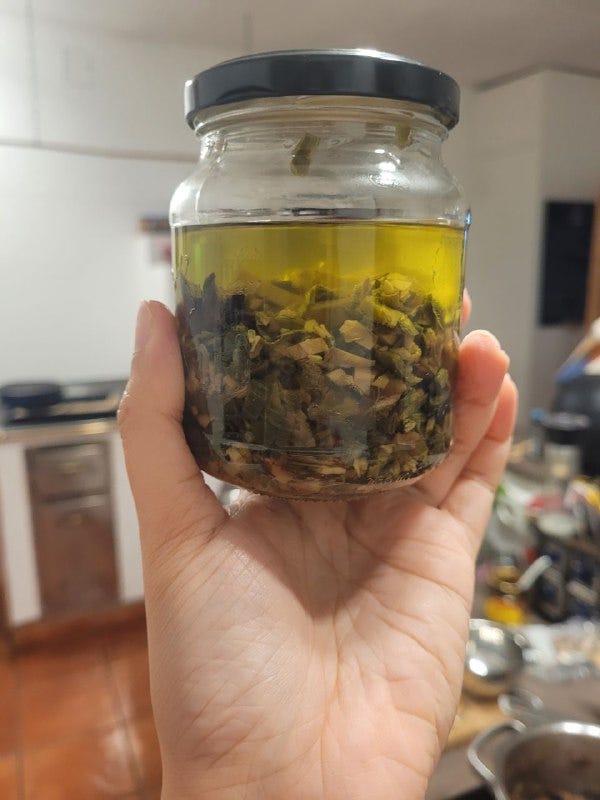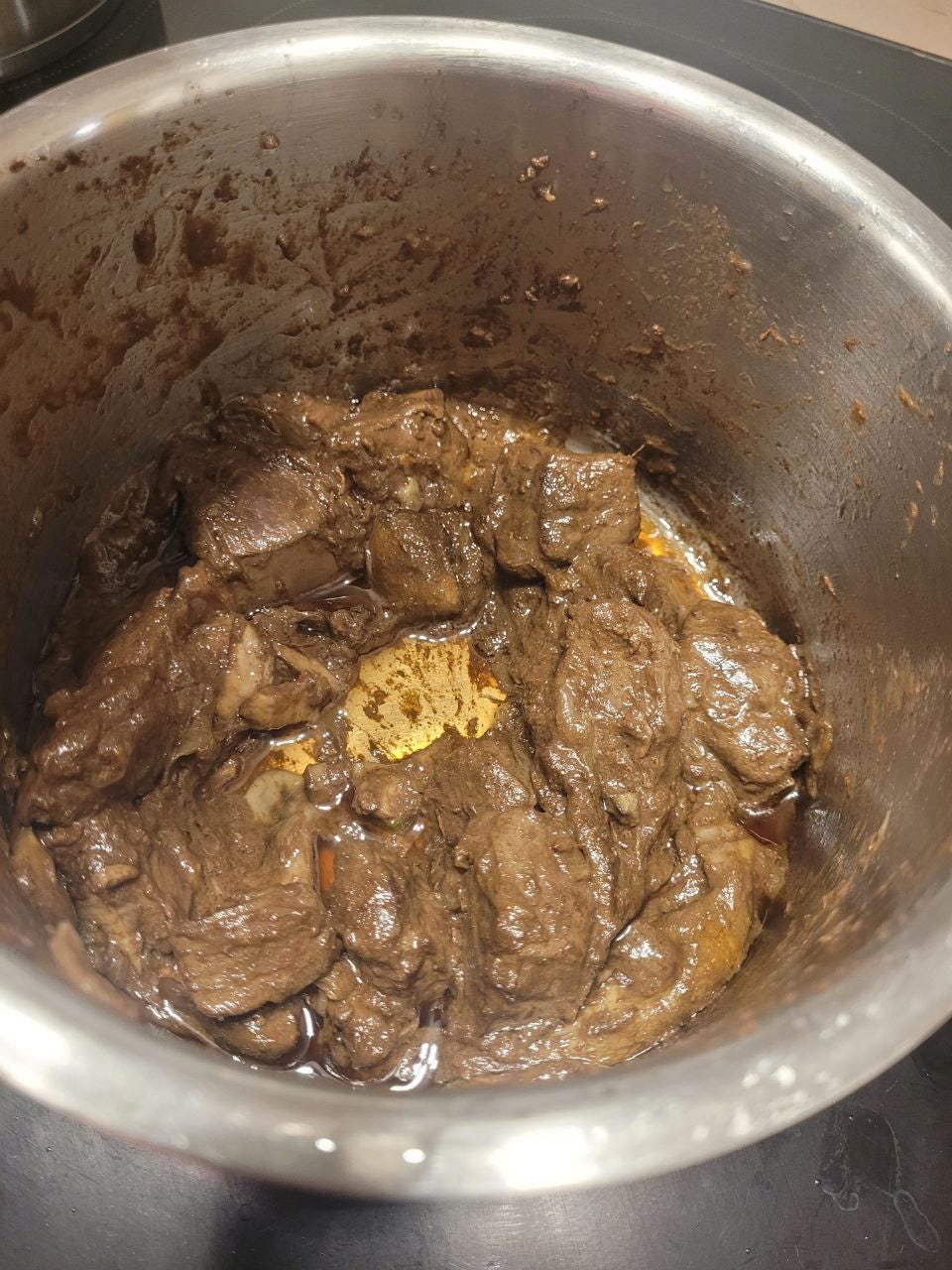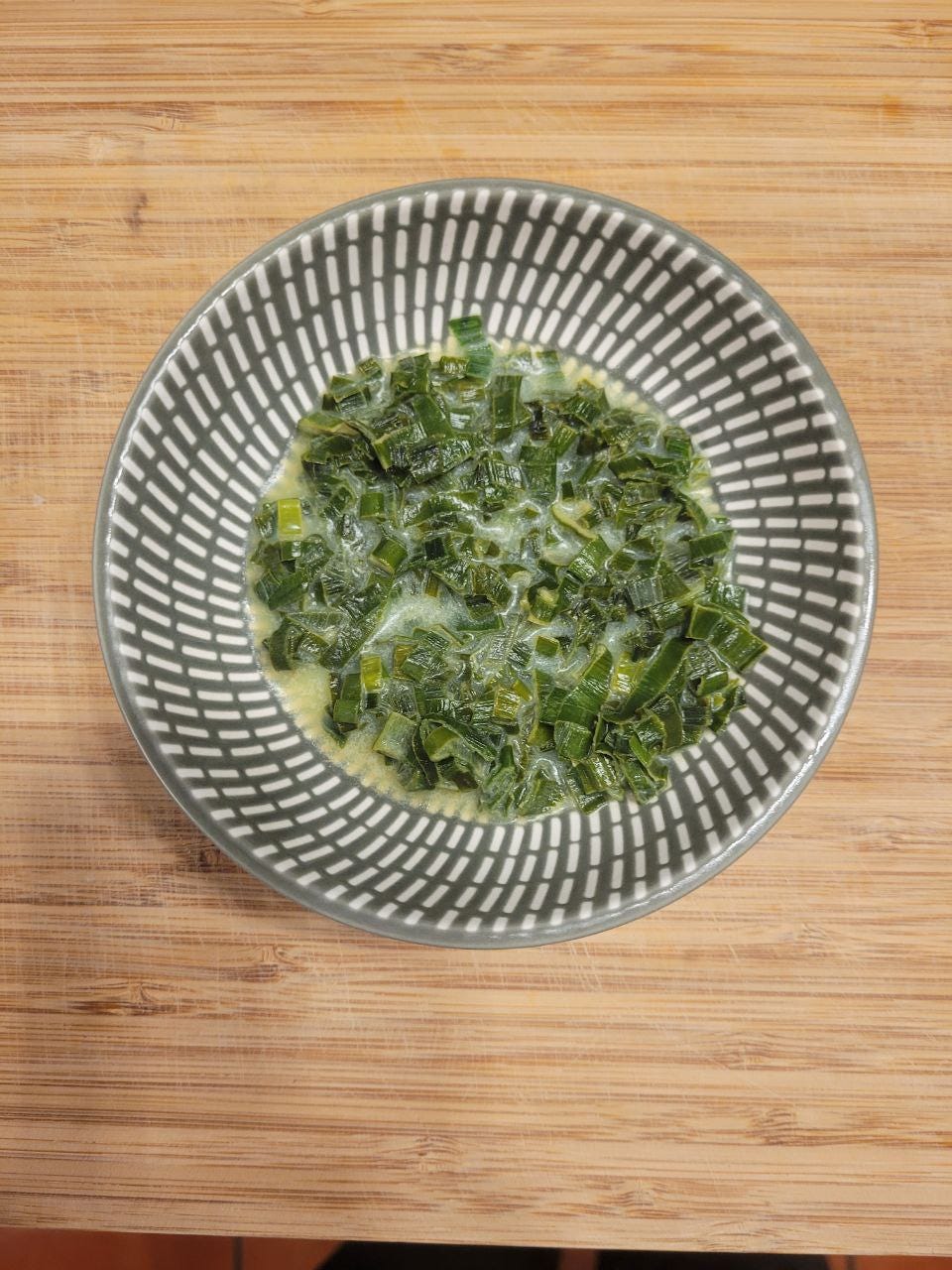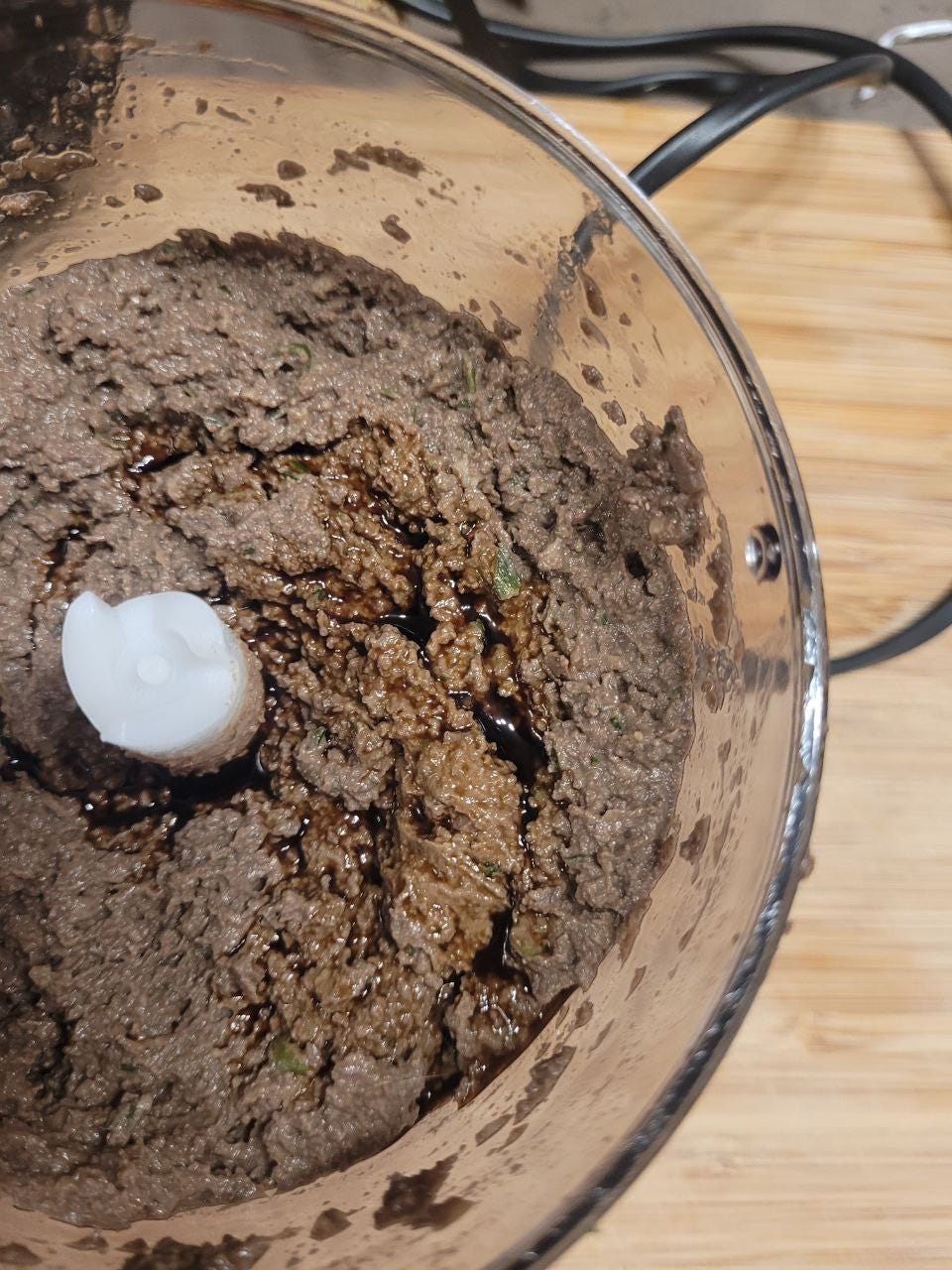No, this has nothing to do with Slovenia except that I did make this while I was pet sitting for a family in the country.
Want me to pet sit for you?
Liver is quite versatile an ingredient but I feel like there has always been a singular approach towards cooking it. It’s either liver and onions or a liver pâté, which are great dishes and some of my favourites. But, as far as adding more ingredients go, I can see shallots are a common theme, so is switching up the alcohol (I have seen scotch, brandy, whiskey, wine); one even had an optional boiled egg, although that does make me curious. I am not shitting on anyone by any means; I love a good liver pâté and it’s not something you can mess up easily. I mean, sure, if you burn it or add the alcohol too soon or the flambé goes wrong and you end up burning the house down. You know, as one does.
Anyway, I was petsitting for a family in Slovenia, in the middle of nowhere, when through one of my offally distracting digressions, I found that the family, along with their neighbours, hunt an animal from the nearby forest every year on Christmas and have a feast. Last year was a deer.
This may make you feel some things but let me put your mind at ease: they live quite harmoniously with their surroundings and ideally prefer to eat more plant-based food than meat-based. They have built an ecosystem within their compound where they maintain their very own vegetable garden as well as a pond that houses a lot of frogs! So, you know, pretty conscious living relatively.
Now, they have a freezer where they keep mushrooms or forest-stuff they foraged. And when I talked about my offal obsession, they were very happy to show me that they had a leftover liver from the deer they had last Christmas. Have I ever eaten venison? Not quite. So this was going to be an experience. They also had the heart, or a part of it, which I didn’t have enough time to use nor was I that interested.
I like the liver, it’s quite fascinating. I mean, the liver regenerates and I don’t think anything is cooler than that. Imagine if our limbs grew back, which might just be cooler.
Venison Liver
What exactly is venison? Venison is derived from its Latin root venari, which means to hunt or to pursue. The modern day word, however, comes from the Norman French venaison, which entered the vernacular through the Norman conquest of England in the 11th century.
More commonly, venison refers to any game meat, which includes antelope, hare, rabbit, wild boar, goats and ibex. However, now when we say venison, we just mean deer meat.
And an even more fun fact: the idiom “to eat a humble pie” finds its way back to the word “umble pie”, a pie made out of the innards of, but not limited to, deer. Honestly, it’s 100% because people thought humble and umble sounded the same (and why wouldn’t it if you just remove the first letter that one might not even pronounce if their language does not have the sound for “h”) and just went with it. The meaning of the idiom has nothing to do with umble either: to eat a humble pie is to face humiliation and subsequently apologise for a serious mistake. Like, I still don’t get where the concept of eating a pie came into this context because have you ever eaten a pie? No humiliation to be found, only glory.
Venison is generally healthy with texture finer than beef. It’s also pretty lean, which means that if you are trying to make burger patties, you have to add additional fat like bacon, cheese, oil or meat that has a higher fat content like beef or pork. Game meat, in general, is pretty great: it’s sustainable, it’s healthy, they live in an environment away from humans. So they are everything farmed animals aren’t; they live off of their natural diets so they are leaner, have lower cholesterol and fat, and are higher in protein.
Venison liver, specifically, and surprisingly, has a big chunk of vitamin B12 (I mean who even says that? “big chunk of vitamin B12”); per 100g, you get 110.29mcg (microgram) where the average daily value (DV, henceforth) of B12 is 2.4mcg, which means there is a 4595% increase. (Venison Nutrient Density, n.d.)
The venison liver per 100g has a total fat content of 1.68g (with a DV of 78g), of which monosaturated fat is 0.2g, polysaturated fat is 0.38g, saturated fat is 1.06g and trans fat is <0.1g. It also is a good source of protein (21.65g), choline (474mg), which helps with our nervous system, brain function and detox, magnesium (16.5mg), and phosphorus (350mg). I mean, it has a host of other important minerals, vitamins, amino and fatty acids, and a total calorific value of 110.15kCal per 100g. (Venison Nutrient Density, n.d.)
I could say that you probably shouldn’t eat deer liver everyday but then again, if you happen to be in a position in your life where you are frequently eating not just deer liver but liver from any kind of game meat, I would very much like to have a conversation with you! And maybe also a doctor, if we have the time.
Game meat is not something we eat every day solely because there is a lot of effort that goes into hunting, skinning the animal, extracting the meat and then preserving whatever is left. I mean, if you are a hunter, you don’t need me to tell you anything. And if you are thinking of hunting for the first time ever, best to do it with someone experienced and read up a bit on it!
Spring Onion Liver Pâté
I enjoy a good liver pâté, especially when I pair it with crackers, a tart blueberry jam (blueberries are my current obsession), parmesan shavings and a glass of Ricci’s Dritto al Cuore. However, I also wanted to see what would happen if I added Chinese spices and aromatics to liver pâté.
Additionally, I made a beautiful spring onion oil first, which has mushrooms, a good amount of garlic and an even better amount of spring onion. Also, if you wanna double down on the offalness of it all, add some chicken skin!
Sorry, I digress. The pâté tastes amazing and here’s the recipe.
What you’ll need:
Venison liver/just any liver, honestly: 500g/1lb, cut into cubes
Spring onion: 2 entire stalks
Mushrooms, I had porcini at hand but use button if you need to: 250g, sliced
Salt: to taste
White Onion: 1 small, sliced. If you have purple onions, even better.
Butter: I am going to leave this between you and your God
Soy sauce: 1tsp, and keep this in mind when you add salt.
Fish Sauce: 1tsp
Chinese 5 spice: 1.5 tsp (it has star anise, clove, cinnamon, Sichuan peppercorns and fennel seeds, all ground)
Rum: 2tbsp; you can use any alcohol, and change the quantity, too. Or leave it out altogether.
Oil: 3tbsp, any neutral oil will do
Garlic: 4 cloves, chopped. But if you add more, I won’t be mad.
Sesame oil: 1tsp
Broth: 2 cups (optional)
Please don’t forget to wash your chopping board with hot water and soap after cutting the liver. Let it dry completely before using it for anything else. Please don’t put this chopping board in the dishwasher.
What you need to do:
Clean your liver. My host had preserved theirs in the animal’s blood, which ensures that it is stays good for longer. But also be prepared for the liver to keep releasing that blood, which kind of helped my case. Anyway, clean your liver. A lot of people soak the liver in milk overnight to offset that very bloody taste, which I personally enjoy. However, I am not sure how it’s going to be to soak the liver in milk while it’s releasing the blood still. So, if you are unsure, just water will do, too. You could change the water every hour for a while before you let it rest overnight in the fridge in water. I, however, thawed it over 2 days and then just soaked it while I got my mise en place ready. I also don’t remove the very thin membrane, that you won’t need a knife for. But if you want to, go for it. Once it is cleaned, and you are nearing your cooking time, cut it into uniform cubes. Back into the water it goes. Or milk or buttermilk. You do you.
Now, get everything else ready. Cut your spring onions, separate the small white onion part from the leaves. We will use them at different times. Slice your onion, your mushrooms. Make sure your blender and every other utensil, ingredient you are using is right around you or you at least know where it is.
I used a sauce pot (1.9l). So, in a saucepot, on medium heat (gas; or in the 6-7 range on induction), add the oil and 1 tbsp of butter. The oil helps the butter melt but not burn.
Add the sliced onion bulb from the spring onion stalk, the sliced white onion and garlic into the pot. Stir well and add a pinch of salt. Cook until onions mellow down a bit.
Once the onions reduce in size, add the mushrooms. I want the mushrooms to release their water and I want the onions to soak in that water, thereby acquiring some of the umami flavour of the mushrooms. Add another tiny pinch of salt. Stir well. Cook until the moisture evaporates from the pan.
Add a bit of butter and then the liver. Another small pinch of salt and stir well. If you think the saucepan has really less oil, you can add a bit of butter but remember, the oil will be released back once the moisture evaporates. All the ingredients that have soaked up the oil will release the oil back out. So, if things are getting away from you or if it’s sticking to the bottom, just reduce the heat a bit. Maybe from medium to medium-low in gas/from 6-7 to 4-5 in an induction. Although, if it is sticking to the bottom in a way that you think it’s burning, change pans immediately.
Add half of the chopped spring onions and mix. We want the spring onion to release its moisture and oils which in turn will get seeped into the liver and the mushrooms. This sentence got away from me a bit, I apologise.
While cooking the liver, you will see that it is releasing more of its residual blood. Keep an eye and stir frequently. The last thing you want is to burn blood, on the stove no less. The blood will actually provide the moisture needed to cook the liver and the mushrooms. But if you see that it is drying up, you can add any kind of broth you have lying around in parts.
If you are worried about the blood, let me ease your mind by saying that it won’t release a huge amount. Most of everything on the pan is also the water released from the mushrooms. Either way, make sure that the moisture from the pan has evaporated and you can see the oil back in the pan.
A surefire way to ensure the liver is cooked is to take a piece out from the pan and cut it. Press it a bit and if you don’t see a single drop of its juice coming out, it’s good to go. Don’t go by just the colour because sometimes it’s pink on the inside but thoroughly cooked! Let it cool down in the pan for a bit because we don’t want the blender to break.
While the liver cools down a bit, on a pan, on low heat, add around 5-6tbsp of butter. Keep the heat low because we are not cooking the butter, just melting it enough. Once the butter has melted, add the spring onion. Stir to combine. Cook this for another 10 minutes. Take it off the heat, transfer to a bowl and refrigerate it.
Now, I already had a spring onion oil which I used here but please feel free to either stick to the ingredients mentioned or use something you have of your own. I blended it part by part, starting with the lowest speed and then moving up. Between blends, we add the spring onion butter, rum, sesame oil, soy and fish sauce. If you think the salt is low, add some. If your spring onion butter runs out, you can use normal butter, too. Essentially what I did here is add delicate flavours while the liver is still pretty warm so that it mixes into the pâté. I didn’t do this while cooking because I didn’t feel like cooking these flavours that I am adding towards the end. If you want to, go ahead! But make sure to wait for the moisture to cook out.
Store it in a container and top it with either butter or any kind of flavoured oil you may have.
You can also add chili oil to accentuate some of the flavours. If you don’t have the Chinese 5-spice blend, you can use garam masala, as it has some of the same spices, or just star anise and cinnamon. If you have za’atar or ras el hanout, also works.
The idea is to not tell you what you can/not add. Try it with a small portion of liver and see how you like it. If you want to make the classic liver pâté, go for it, as long as you are diversifying your plate. We have way too many resources for us to be picky and choosy, especially when a huge chunk of the world goes to bed hungry. Of course, I am not guilt-tripping you - you can just choose not to. I have days where I repeat the same food because I am feeling overwhelmed and tired. Or just because I feel like it.
But maybe you can visit your local butcher shop and try something new, even if it’s for the first and last time ever.
If you have a recipe that you’d like me to make and share, let me know! I will feature you and I would love to have a chat!




